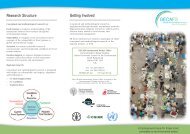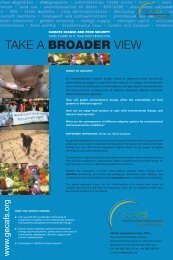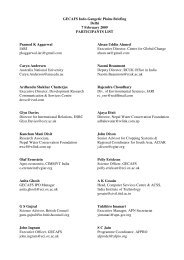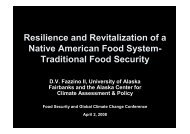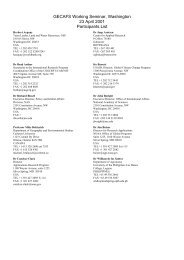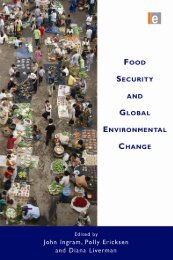From Food Production to Food Security - Global Environmental ...
From Food Production to Food Security - Global Environmental ...
From Food Production to Food Security - Global Environmental ...
- No tags were found...
Create successful ePaper yourself
Turn your PDF publications into a flip-book with our unique Google optimized e-Paper software.
organizations made up of numerous national governments, <strong>to</strong> national and local governance structuresin the country in question, agree that there is a problem and understand and concur on its severity.This consensus-building is very difficult and in many situations is often based on the quantitativeremote sensing imagery that provides irrefutable evidence of a significant reduction in foodproduction. Although everyone agrees that political and economic fac<strong>to</strong>rs are usually far moreimportant in determining food access and ultimately food security of a region, it is often thebiophysical evidence that all parties can agree upon as being ‘real’, valid and conclusive. This putsremote sensing at centre stage in famine early warning systems, even in an era of widespreadtelecommunication systems that have greatly increased information availability from remote regions.Once stakeholders agree <strong>to</strong> the nature and scope of the problem and come <strong>to</strong> the table <strong>to</strong> discuss what<strong>to</strong> do about it, then they are able <strong>to</strong> address the underlying political and economic causes of theproblem through efforts <strong>to</strong> engage partners <strong>to</strong> provide income support, clean drinking water, healthinterventions and other responses appropriate <strong>to</strong> the situation in addition <strong>to</strong> food aid.As stakeholders continue <strong>to</strong> increase their attention and focus on food security issues outside of foodavailability, the pressure will grow <strong>to</strong> transform the food aid system <strong>to</strong> provide information on thewider food system’s functioning during a crisis (Okali et al., 1994; Haggar et al., 2001; Brown, 2008).How <strong>to</strong> engage stakeholders in research planningAs noted above, stakeholder engagement is of great importance in the research design phaseand a combination of approaches (consultancies, agenda-setting workshops and informalapproaches) can be employed <strong>to</strong> help set the agenda. Each of these is discussed below.Consultancies. Consultancies, where researchers are hired <strong>to</strong> ascertain stakeholder views,prove particularly effective in determining information need from stakeholders who wouldnot normally participate in, or feel comfortable at, an ‘academic’ brains<strong>to</strong>rming workshop.Examples of stakeholders who would be consulted for regional-level input include seniorpolicy advisors from intergovernmental organizations or regional bodies (e.g. SouthernAfrica Development Community, SADC; European Commission), resource managers (e.g.operations managers of major/trans-boundary irrigation schemes), and representatives fromspecific target groups (e.g. farmer associations or major supermarkets). Careful selection ofconsultants is important: local researchers who are experienced in stakeholder dialogue(rather than international experts) usually have the best feel for the nature of the issues atregional level, and generally have the best contacts (sometimes personal, sometimesprofessional) and hence access <strong>to</strong> interviewees. A small team might be needed <strong>to</strong> collectivelycover the main science areas. A ‘down side’ of this process is that interviewees may notstrongly feel part of a collective agenda-setting exercise, and do not benefit from discussionwith others in a workshop setting.Agenda-setting workshops. These bring the researchers <strong>to</strong>gether with the various stakeholdersand are commonly used in designing research projects. They have the advantage of sharinginformation more openly. Workshop outputs can be seen <strong>to</strong> be a product of collective76



